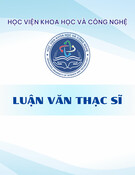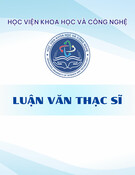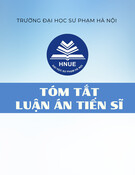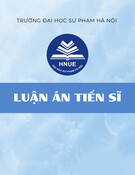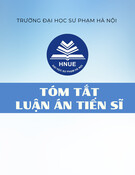MINISTRY OF EDUCATION AND TRAINING
HO CHI MINH CITY UNIVERSITY OF ECONOMICS
FARMER ECONOMIC DEVELOPMENT
KHMER POPULATION IN CUU LONG RIVER DELTA
UNTIL 2030
Major: Political Economy
Code: 9310102
SUMMARY OF THESIS WILL ADVANCE ECONOMIC
HO CHI MINH CITY, IN 2020
The work was completed at: ………………………………….…
Science instructor:………………………………………….
(specify full name, scientific title, degree)
Reviewer 1: ………………………………………………………….
Reviewer 2:
………………………………………………………… ..
Reviewer 3:… .. …………………………………………………….
The thesis will be defended before the Thesis Assessment Council
at the school level at
……………………………………………………………… ..
At …… hour …… day ……. month…. year …….. Thesis can be found at the library: …………………………………
PREAMBLE
1. The urgency of the research Cuu Long River Delta region is a region of great potential,
diverse in natural resources, diverse in culture, ethnicity and
religion, in which the Khmer people account for a very high
proportion. Although the income of the Khmer ethnic minorities has
improved significantly in recent years, however, compared to the
general level of the whole country, the life of the Khmer in the Cuu
Long River Delta region still has many difficulties and is facing
many difficulties. challenges in economic development, ensuring
social security, taking care of the material and spiritual lives of the
residents, especially the poor; to associate economic development
with cultural development, sociopolitical stability and maintenance
of national defense and security in border areas. With the desire to
contribute to overcoming these difficulties for the Khmer ethnic
minority, I decided to choose the topic: "farmer economic
development Khmer population in Cuu Long River Delta region
until 2030".
2. Objectives and research missions Research objectives: (i) General theory, (ii) Analyze and
assess the current situation, (iii) Propose solutions for economic
development of Khmer ethnic minority farmers in the Cuu Long
River Delta region until 2030.
Research questions: (i) Is it necessary to develop the
economy of Khmer farmers in the Cuu Long River Delta region? (ii)
What is the current situation of economic development of Khmer
ethnic minority farmers in the Cuu Long River Delta region in
recent years? (iii) What are the main factors affecting the economic
development of Khmer ethnic minority farmers in the Mekong
Delta? (iv) What solution for economic development of Khmer
ethnic minority farmers in the Cuu Long River Delta region in the
coming time?
Research tasks: review researches near the topic and
systematize the theories of the urban residential areas of Khmer
Delta; approach from the perspective of political economy, consider
the Khmer farming household economy as a part constituting
production forces and production relations; research on policies for
ethnic minorities in the Cuu Long River Delta region in general and
Khmer in particular; Direct access to Khmer specialties, learn
economic, social activities, customs, practices, religions, beliefs ...
3. Object and scope of the study Object of study: Basic economic activities of Khmer farmers
in the Cuu Long River Delta region in the period of 2009 2019 to
propose basic solutions to develop residential areas in the Cuu Long
River Delta region by 2030.
Scope of the study: Space: provinces in the Cuu Long River
Delta region. In terms of time: the topic researches the economic
development of Khmer ethnic minority farmers in the Cuu Long
River Delta region is limited in the period from 2009 to 2019.
Orientations and solutions are researched in the period from year
2020 2030.
4. New contributions of the thesis The dissertation contributes to generalizing basic theoretical issues. Analyze the process of mobilizing and developing the urban residential areas of the Khmer in the Cuu Long River Delta region in the transition economic conditions.
Contribute to providing a fairly comprehensive picture of economic activities of Khmer farmers in the Cuu Long River Delta region. Outlined orientations and groups of basic solutions to serve the research, proposing guidelines and policies for the Khmer Cuu Long River Delta region in particular and the Khmer Delta in general until 2030 in terms of adaptation. with the current climate change situation.
5. The structure of the thesis The thesis is presented in structure: Introduction and 5
content chapters.
CHAPTER 1
OVERVIEW OF RESEARCH SITUATION
1.1. Research overview of foreign authors on household
economy, farmer household economy
1.1.1. Researches of foreign authors on household economy,
farmer household economy in some countries around the world
TChayanov (1924) considered farming household economy
as a production method that existed in all social regimes. According
to Hunt (1979), Hayami and Kikuchi (1981), as demographic and
labor pressures on land are increasing, land prices are increasing,
land use costs are increasing, demand and ability to improve
thoroughly. production technique increases, production not only
meets the needs of selfconsumption of the family, but must sell to
the market, put themselves in front of the market to behave.
Vergopoulos, Taussig (1978) point out that the household
economy has an advantage over production because this form of
production is most likely to better employ rural labor and keep farm
prices. lower than the large production of capital. J. Harris (1982) has
classified research on rural areas, agriculture, peasants into three
main trends, including: system approach tendency, decisionmaking
model tendency and historical structure approach. Lipton (1989)
studies show that three approaches in agriculture are macoxide;
classic and collective goods.
1.1.2. Foreign authors' research on the lives of rural people,
ethnic minorities and Khmer ethnic minorities in Vietnam The project "Analysis of the current situation of poverty and
poverty in the Cuu Long River Delta region" (MDPA) is
implemented by World Vision Organization in conjunction with
Adam Ford Company. In particular, in the topic 3: "The Khmer in the
Cuu Long River Delta region" of the project, the authors have
clarified the causes of poverty in the Khmer community, identified
opportunities as well as barriers. barriers to the economic growth and
development of the Khmer ethnic minority.
World Bank (2012) in Vietnam's 2012 Poverty Reduction
Achievement Report Achieved Aspects of Vietnam in Poverty
Reduction and New Challenges.
Philip Taylor (2012) analyzes the problems posed in the
process of rural construction in the Cuu Long River Delta region
through research on life, customs, religion, ethnic psychology, rich
and poor differentiation, ... in the whole process of socioeconomic
development and the influence of the market economy and
government policies.
IPSARD, CIEM, DERG, UNUWider (2016) an overall
study on rural household economic characteristics was conducted
jointly by IPSARD, CIEM, DERG, and UNUWider from 2006 to
2016 on the Table 12 provinces, including Lao Cai, is one of the
important documents to help assess the situation of household
economic development in Lao Cai.
1.2. Research overview of domestic authors on household
economy, farmer household economy and ethnic Khmer
1.2.1. Research overview of domestic authors on household
economy, farmer household economy with studies of the authors:
Tran Tien Khai, Doan Quang Thieu, Nguyen Do Huong Giang, Mai
Thi Thanh Xuan and Dang Thi Thu Hien, Do Van Quan, Nguyen
Thang and La Son Kha, Nhu Hung Cao, Thesis by Nguyen Tien
Dung, Nguyen Van Cong, Nguyen Thi Thu Thoa, Huynh Kim Thua.
1.2.2. Overview of researches on ethnic Khmer in the Cuu
Long River Delta region with researches of authors: Nguyen Thanh
Thuy, Nguyen Tan Thoi, Le Tang, Mac Duong, Vo Van Sen and
Phan Van Dop, Hoang Thi Lan , Vo Thi Kim Thu, Research Team
of the University of Sussex and the Vietnam Academy of Social
Sciences, Ngo Phuong Lan, Mai Chien Hieu, Nguyen Thi Thuy Anh
and Nguyen Van Thuc, Huynh Van Dien, Mai Chien Hieu, Vo Thi
Kim Thu.
1.3. Assess the research situation 1.3.1. The contributions of the studies
All the authors' research, topics, dissertations, dissertations,
articles ... mentioned about farmer households' economy,
households, farmers' life in Vietnam, life of the Khmer people in
many different angles and in many different areas.
1.3.2. Research gap
Although there are quite a lot of researches on many
different aspects of the economy of farmers' households, households,
the life of farmers in Vietnam, farmer households in the Cuu Long
River Delta region, the life of the people. Khmer people and the
basic issues of the Khmer people in the Cuu Long River Delta
region,... But researches on Khmer ethnic minorities related to the
topic only stop at research. in a comprehensive way about
demographics, life, customs, practices, methods of production,
livelihoods, policies of the Party and State towards the Khmer ethnic
minority,... while indepth research economic research on
households of Khmer ethnic minority farmers in the Cuu Long River
Delta region in order to generalize a comprehensive picture of the
economic life of ethnic Khmer in the trend of industrialization,
modernization and national integration. economic development and
sustainable development, adapting to current climate change, from
which to see the economic development problem of Khmer ethnic
minority farmers will have an impact. If influencing or even
deciding on other areas of social life, including political security
issues is a very necessary work the previous studies have not been
studied in depth, not yet. point out specifically. Therefore, the topic
focuses on continuing to study in depth and clarify issues related to
economic issues of Khmer ethnic minority farmers in the Cuu Long
River Delta region.
CHAPTER 2
THEORETICAL AND PRACTICAL BASIS OF
DEVELOPMENT
ECONOMICS OF ETHNIC FARMERS
2.1. Concepts, characteristics, roles and trends in
household economic movement and development in the current
period
2.1.1. Concepts and characteristics of household economy,
farmer households, and household economy
2.1.1.1. Household economy: “A household is a basic unit of
the society related to production and consumption, and is seen as an
economic unit” (Le Trong, 1995).
2.1.1.2. Farmers: "Farming households are a social economic
cell, a basic form of economy in agriculture and rural areas" (Le
Dinh Thang, 1993).
2.1.1.3. Farmers' economy: Farmers are an economic unit
mainly in rural areas, operating in the agricultural sector, so it is
necessary to systematize to form theories about economic
development of farming households. Theoretical premise for
considering, evaluating and making policies for agricultural and
rural development.
Tachaynov (1924) argued that a farmer's economy was a
type of production that existed through different regimes. In each
mode of production has its own rules of development, and in each
mode, it seeks to adapt to the current economic mechanism. Farmers'
goal is to have a high income, regardless of the source of that
income comes from any agricultural production.
2.1.2. The role of the household economy in the national
economy
Household economy is a stepping stone, a bridge to
transform the natural economy to a commodity economy; household
economy is the unit that accumulates capital for production and
business; household economy is the base unit performing the social
division of labor; household economy is a grassroots economic unit
that receives and applies scientific and technological advances to
production business; The household economy creates products that
supply the market's needs.
2.1.3. Trends in mobilizing and developing the household
economy in the current period
To develop farmer households' economy in the direction of
forming family farms
To develop farmer households' economy in the direction of
forming forms of economic integration.
2.2. Theories and models of rural household economic
development
2.2.1. Farmers' economic theory by K.Marx and V.I.Lenin
K.Marx and V.I.Lenin both agree on the concept that
household economy will last for a long time, during the transition to
socialism.
In addition, V.I.Lenin always appreciated the role of peasants
and considered alliances with this force as an important condition for
the Russian proletariat to successfully implement the socialist
revolution. Properly assessing the role of peasants in the socialist
revolution together with bold and correct policies starting from
agriculture, the peasants are one of the reasons for the initial success of
economic policy. The new economy (NEP) initiated by V.I.Lenin in
March 1921, is presented for the first time in his work "Discussing Food
Taxes".
2.2.2. The theory of farmer family business by TChayanov
Tchayanov has come to the conclusion that a farming economy
is resilient, confrontable, and resilient because on the one hand there is a
balance between labor and consumption needs, on the other hand it is
not under pressure. too heavy of fluctuations in profits like capital
enterprises, especially the pressure of loss to bankruptcy.
2.2.3. Hunt's theory of farm economics (1979)
According to Hunt (1979), Hayami and Kihuchi (1981), as
demographic and labor pressures on land are increasing, land prices are
increasing, land use costs are increasing, demand and ability to improve
production technology increases, production not only meets the self
consumption needs of the family, but has to sell to the market to
behave.
2.3. Characteristics and factors affecting the economic
development of ethnic Khmer farmers
2.3.1. Characteristics of the Khmer's farming household
economy
Features include: Head of household and household members
are Khmer; The Khmer's farming household economy is still heavily
selfsufficient and selfsufficient; the structure of production business
is increasingly diversified, in which agriculture is the foundation; small
scale of production; income and living standards still face many
difficulties.
2.3.2. Factors affecting economic development of farming
households of the Khmer ethnic minority
2.3.2.1. Group of factors belongs to production forces
The group of factors belonging to production forces includes:
geographical location and land; climate, weather, ecological
environment and climate change; labor, capital and infrastructure;
science and technology.
2.3.2.2. Group of factors belongs to production relations
The group of factors in production relations includes:
ownership relations of the means of production; production
management and organization relations; product distribution relations.
2.3.2.3. Psychological and customs factors
Most of the ethnic Khmer follow Southern Buddhism. The
main source of income comes from cultivation, animal husbandry and
seasonal labor.
2.3.2.4. Group of factors on macro management of the State
State policies on tax, land, product protection, credit,
investment, trade, ethnic groups, disadvantaged regions ... will greatly
affect the socioeconomic development of the lowlands. ethnic
minorities in general and Khmer's farming household economy in
particular.
2.3.2.5. Factors group about the influence of external
conditions
External conditions (geographical location, farming techniques,
consumer markets, agricultural subsidy policies, political situation,
industrialization and modernization trends associated with economic
development knowledge, the process of international integration, ...)
also affects the economic development process of the Khmer ethnic
minority farmers.
2.4. Experiences in the process of implementing policies
towards ethnic minorities in some countries, some localities in
the country and lessons learned for economic development of
Khmer ethnic minority farmers in the Cuu Long River Delta
region
2.4.1. Experience in a number of countries
The policy towards ethnic minorities in the developed
countries is considered to be implemented frequently, but the
implementation level varies, but in general there are two commonly
used policies to reduce the gap between rich and poor. between
ethnic minorities and other ethnic groups.
2.4.2. Experience in a number of localities in the country
2.4.2.1. Lao Cai Province
The innovative and effective implementation of the State's
investment and support programs and policies has significantly
contributed to promoting the relatively equal development of ethnic
minority communities in the province. The expansion of tourism
activities to villages has created employment opportunities and
increased income for the ethnic minority community, with an
average income from CBT 2535 million VND/household/year.
2.4.2.2. Lang Son Province
Along with that, Lang Son implements many investment
programs and policies, supports people in production, economic
restructuring, increases income and reduces poverty sustainably.
First of all, the policy of allocating residential land and production
land for ethnic minorities is concerned. At the same time, the
province directs localities to coordinate well implementing the
policy credit program to help people have capital for household
economic development. At the same time, the agricultural sector
also promotes agricultural and forestry extension activities in order
to transfer science and technology and bring new highyield and
quality plants and seeds into production.
2.4.2.3. Kon Tum Province
Construction investment in socioeconomic infrastructure
has been promoted, especially in three dynamic economic regions.
Traffic system has been invested and upgraded; irrigation works and
clusters have been repaired, ensuring to well serve the people's
drinking and production water needs; urban infrastructure,
education, health, science and technology, culture, sports, tourism ...
are focused on investment.
2.4.3. Some lessons for economic development of Khmer
ethnic minority farmers in the Cuu Long River Delta region
2.4.3.1. Successful experience
Consists of five successful experiences drawn from
researching countries and some localities in the country. In which, it
is strongly recognized that countries and localities have fully
exploited local advantages to develop economic and well implement
policies towards ethnic minorities.
2.4.3.2. Experiences need to be researched and adjusted
accordingly
Including eight experiences that need to be researched and
adjusted accordingly. Which mentioned issues that need to be
adjusted in terms of policies to synchronize and promote efficiency;
to change the structure of plants and animals to suit the advantages
of each region and each locality; It is necessary to invest in
synchronous infrastructure and pay attention to training cadres for
ethnic minority areas.
CHAPTER 3
RESEARCH METHODS
includes materialistic
3.1. Research methodology: dialectical methodology, scientific abstract method.
3.2. Specific research methods on economic development of Khmer ethnic minority farmers in the Mekong Delta: the method of analyzing collected information/data, survey, survey,
method of interview, method of analysis synthesis, statistical
method.
3.3. Research data: includes secondary data and primary
data
3.4. Recommended analytical framework for the thesis
CHAPTER 4
REAL SITUATION OF ECONOMIC DEVELOPMENT
KHMER ETHNIC FARMERS IN THE CUU LONG
RIVER DELTA
4.1. Overview of natural, socioeconomic conditions
affecting economic development of Khmer ethnic minority
farmers in the Mekong River Delta
4.1.1. Overview of natural, socioeconomic conditions in the
Mekong River Delta
Overview of natural and socioeconomic conditions in the
Mekong Delta that affect the economic development of farmers in the
Khmer Mekong Delta in the Mekong Delta.
4.1.2. Characteristics of the ethnic Khmer in the Mekong
Delta
General characteristics About culture, customs, customs,
religion, awareness, festivals.
4.2. Situation of economic development of Khmer
farmers' households in the Mekong River Delta in the period
2009 2019
4.2.1. Current situation of production force development of
Khmer ethnic minority farmers in the Mekong River Delta
4.2.1.1. In terms of demographics and labor force
Through a survey of 300 households with 1,386 people in 5
districts, the number of people under the working age is 351,
accounting for 25.32%, 789 people in the working age group,
accounting for 56.92%. 239 people, accounting for 17.24%.
Considering each district, the total percentage of people under the
working age and over the working age accounts for about 40% of the
total number of surveyed demographics.
The average household member / household indicator is
highest in the group of households with income group 3 (4.96
people), and the lowest in the group with income group 1 (4.20
people). Average labor / household is highest in group 1 (2.65
people) and lowest in income group 3 (2.15 people). The highest
number of consumers / 1 employee is the income group of group 3
(2.28 people), the lowest is the income group of group 1 (1.35
people).
4.2.1.2. Educational attainment by age group and by sex
Survey results of 1,386 Khmer people showed that: illiterate
people and primary school students accounted for a high proportion
(39.2% and 41.3% respectively) of the total surveyed population;
while the proportion of people studying at lower secondary school
and above only accounts for 19.2% of the total population surveyed.
The survey shows that the working force in the Khmer ethnic
minority's age has received little training, the number of people who
are illiterate accounts for a high percentage and even the number of
literate people in working age, their educational level is also. low,
concentrated in primary school.
4.2.1.3. Production materials of ethnic Khmer farmers in the
Mekong River Delta
* Land:
If according to the type of land used, the average agricultural
land for all 5 districts is 41.6%, livestock and garden land is 19.9%.
Survey data shows that the higher the income Khmer households
have, the higher the percentage of agricultural, livestock and
gardening land. * Capital production:
The average capital level of Khmer farming households in 5
districts is 41.11 million VND, of which the highest is My Tu town:
42.53 million VND, Giong Rieng is the lowest 40.30 million VND
(table 4.11). . Regarding the average capital of Khmer farmers, it
shows that equity accounts for 22.51%, loans account for about
15.89% and other capital accounts for a very low proportion of
2.71%.
Analyzing the investment capital of household groups by
income size, households with significant differences in investment
capital. The income household of group 1 has the average capital of
VND 60.21 million, the income household of group 2 is VND 40.60
million and the income household of group 3 is VND 21.22 million.
Through this, it is found that the investment capital of Khmer
farming households is very different from one region to another.
Households in highland, remote and isolated areas have lower
average capital.
4.2.1.4. Production results of Khmer ethnic minority farmers
in the Mekong River Delta
* Total income of Khmer farmers in the Mekong River
Delta:
The average total revenue from agriculture of 300 surveyed
farmers in 2019 is 32.14 million VND, of which income from
cultivation is 23.14 million VND, breeding is 8.2 million VND and
from fishing is 2.79 million VND.
In addition to the revenues from agriculture, some farmers
also have a small proportion of revenues from outside agricultural
production such as carpentry, masonry, textile, ...
* Production expense:
Analyzing by industry, the average cost of Khmer
households in the Mekong Delta is 11.42 million VND. In which, the
farming sector was 6.96 million VND, accounting for 60.95%,
husbandry was 3.10 million VND, accounting for 27.14% and fishing
was 1.36 million VND, accounting for 11.91%.
* Remaining income of farmer households:
Survey results show that the average annual income of
Khmer farmers from agricultural production is 22.62 million VND,
of which income from cultivation is 16.18 million VND, accounting
for 71.53%. husbandry 5.09 million VND, accounting for 22.51%,
fishing 1.35 million VND, accounting for 5.94%.
Table 4.20. Average income by employees and demographics year 2019 Unit: Million VND
Local Total income Total income/ demographic
Overall average Tra Cu district My Tu district Tri Ton district Giong Rieng district Vinh Loi district 22,62 21,62 21,72 23,11 23,57 23,08 4,83 4,62 4,64 4,94 5,04 4,93 Total income/ labor 9,63 9,20 9,20 9,83 10,03 9,82
(Source: Data compiled from the survey)
If analyzing by locality, due to the similarity in natural,
economic and social conditions among Khmer farming households
in the Mekong Delta, the forms of production and business of Khmer
households in this area have similarities, mainly living by
agricultural production, of which cultivation accounts for a high
proportion (71.53%) compared with the rest.
Looking at the average income of Khmer farmers, if
assessed as a whole, Khmer farmers have very low income. It can be
demonstrated: If the average annual income in agricultural
production (excluding income from wages, wages in other sectors)
divided equally by the average number of people each. For families
(4 to 5 people) and divided by 12 months (22.62:4:12), the average
income per person is only about 500,000 VND / person / month.
Although it is known that in addition to income in agricultural
production, Khmer farmers also have other sources of income, for
example in the present rural area, the income source of Khmer
households in the Mekong Delta is not only from agriculture but also
from income from many other sources as well, that is income from
hired labor, from processing services, product sales services ...
Income from agricultural production accounts for 66.25% of
the total income of Khmer farmers, net income outside agricultural
production after subtracting costs accounts for 14.16% of net income
from agricultural production. However, if comparing the non
agricultural income to the total income without costs, the non
agricultural income only accounts for 9.38% of the total income.
4.2.2. Current status of production relations development of Khmer ethnic minority farmers in the Mekong River Delta
4.2.2.1. Ownership relations about the production
materials
Through survey data on land scale, in particular, the land use rights of Khmer farmers in the Mekong Delta shows the status: Land use rights of less than 0.5 ha of Khmer households account for high rate: 52.1%; from 0.5 ha to less than 01 ha, accounting for 22.6%; from 02 ha or more: 7.5%. Households with more land area will have higher income (highest is households with land size over 2 ha), which shows that land size has a great impact on income and economic development. sacrificing households of the Khmer ethnic minority in the Mekong River Delta.
4.2.2.2. Production management and organization
relations
The Khmer's economic life for a long time has been based on agricultural production, rice monoculture and cow raising are their traditional industries. Transfer of production techniques and technologies to promote comprehensive agricultural production in combination with cultivation, husbandry, and aquaculture and expand production business models as well as open more industries. New jobs in rural areas in the Khmer are still facing many difficulties.
4.2.2.3. About product distribution Through research on the accessibility of Khmer farmers in the Mekong Delta, most of the households that produce goods are concentrated in lowland areas and along national highways and provincial roads, towns and townships. There is a lack of information in some production places of the
household, so the prices are pressed by traders, which partly affects the household's income. Surveys of markets, small business places and households of Khmer farmers who produce agricultural products show that the consumption forms of products are very diverse.
4.2.3.
General assessment of the economic development of Khmer ethnic minority farmers in the Mekong River Delta for the period 2009 2019
4.2.3.1. Results achieved and causes To move from selfsufficiency and selfsufficiency to commodity economy, step by step develop large production; production structure and industry have been progressively improved; the economic capacity of the Khmer ethnic people has been strengthened; Many Khmer farming households tended to use production factors more and more appropriately and brought initial economic efficiency; creating many jobs, increasing income and living standards of the majority of ethnic minority people; Farmers' economy in the Khmer Delta in the Mekong Delta has developed, especially some households have followed the form of family farm economic production, contributing to the implementation of labor and employment issues and protecting the ecological environment of Region.
4.2.3.2. Difficulties, limitations and causes In addition to the remarkable achievements, the economic development process of Khmer ethnic minority households in the Mekong Delta over the past years still has many difficulties, challenges, in general there are "six
shortages". : lack of investment resources; lack of workers with professional and technical qualifications; lack of qualified staff; lack of productive land; lack of funds; lack of access to and production orientation according to market demand.
4.2.3.3. The problems posed Making the most of natural resources; investment in resources for the economic development of nonKhmer ethnic households such as capital, labor, land; the application of science and technology to production; efficiency of production organization, management, selfreliance, selfreliance, will to rise of people is not high; the issue of the output market; infrastructure system problem; management role of the State; ensuring political security and social order in the Khmer Delta; knowledge level of economic development in the period of international integration of the majority of farmer households of ethnic Khmer in the Mekong Delta.
CHAPTER 5
SOLUTIONS FOR THE ECONOMIC DEVELOPMENT OF
KHMER ETHNIC FARMERS IN THE CUU LONG RIVER
DELTA
5.1. The basis for proposing solutions 5.1.1. Domestic and international context: These include
advantages for economic development of Khmer farmers in the
Mekong Delta and difficulties to economic development of Khmer
farmers in the Mekong Delta.
5.1.2. Opinion
Firstly, the development of the Khmer Mekong Delta of the
Mekong Delta must be associated with the economic growth of the
Mekong Delta and be a part of the socioeconomic development
strategy of the Mekong Delta.
Second, the development of the Khmer Mekong Delta of the
Mekong Delta must be associated with the implementation of social
progress and equity, narrowing the gap between rich and poor as
possible between ethnic groups in the Mekong Delta.
Thirdly, to develop the Khmer Mekong Delta of the Mekong
Delta in a sustainable manner to maintain sociopolitical stability in
the development process.
Fourth, combine closely the measures: advocacy, economics,
culture, education, vocational training ...; enhance and maximize the
role of resources in the development of the Khmer Mekong Delta
region in the Mekong Delta.
Fifth, increase the leadership role of the Party and the State
management for the development of the Khmer Mekong Delta region
in the Mekong Delta.
5.1.3. Orientation
Firstly, rapid development is associated with economic
sustainability of Khmer ethnic households in the Mekong Delta.
Second, expanding production and business, forming family
farms.
Thirdly, to expand and improve the efficiency of association
and cooperation towards diversification.
Fourth, economic growth is in harmony with the realization
of progress, social justice, improvement of the quality of life,
protection and improvement of the environment.
Fifth, closely combine with maintaining sociopolitical
stability, strengthening national defense and security in border areas
and islands, firmly defending Vietnam's independence, sovereignty,
unity and territorial integrity. Southern Khmer ethnic minority area in
the Mekong Delta.
5.2. Content solutions
5.2.1. Group of solutions for developing production forces
Solutions for developing production forces include: solutions
to training and fostering a contingent of Khmer cadres; improve
people's intellectual level, do well in vocational training, create jobs
and eradicate poverty; solutions to promote natural resources,
effectively mobilize and use capital resources, land and develop
infrastructure.
5.2.2. Solutions for developing relations of production
5.2.2.1. Solutions to develop ownership relationships on
production materials
It is necessary to adjust the policy of land use right allocation
in the direction of increasing the area and timing of land use right
allocation to Khmer farmers.
5.2.2.2. Production management and organization solutions
* Application of scientific and technological advances to
production of Khmer ethnic farmers:
Encourage ethnic minority people to increase the application
of the program "3 decreases 3 increases" towards real efficiency and
quality. At the same time, building and replicating the model of water
saving combined with "3 decrease 3 increases" in rice production.
* Development of newtype cooperatives and cooperative
groups serving the economic development of Khmer ethnic farmers
in the Mekong River Delta:
The trend of association in production and business is widely
applied in countries around the world to improve labor productivity.
Particularly in Vietnam, this linkage is very important to promote and
promote in the coming time because the current productionbusiness
method of Vietnamese workers is still heavily influenced by
production practices. selfsufficiency, small and fragmented
production. This production practice is more than ever, now in the
trend of international integration, it is required to be updated and
replaced by the form of association into cooperatives and cooperative
groups. In the coming time, the State should create a mechanism to
promote various forms of linkage between Khmer farming
households and enterprises in various forms.
* Improve organizational and management efficiency of
Khmer ethnic farmers:
In terms of theory and practice, it shows that, in terms of
market economy development, opening up and integrating with the
outside, the association and cooperation in production business is an
inevitable trend. However, because the level of our country's
production force in general, especially in agriculture and rural areas
is still low, the organization of types of association and coordination
in recent years has not met the requirements.
Comprehensive and sustainable economic development of
Khmer ethnic minority farmers:
The current weakness in production is that there is no optimal
model for development. Therefore, in the coming time, in order to
develop the economy of the Mekong Delta in general and the Khmer
Delta in general, it is necessary to study a new economic
development model to overcome the current production situation
mainly based on the exploitation of natural resources. Instead, there
are sustainable and effective development models in both the
immediate and long term.
5.2.2.3. Solutions for product distribution and
consumption markets
Product consumption is the decisive stage for the capital recovery and profitability of the producer. However, this is the stage where commodity producers are least able to own the goods because they are often passive with the market. Producers of goods, especially farmers, often bear many risks at this stage. Common risks are price fluctuations, market fluctuations in the direction of narrowing demand, unfair competition of competitors,...
5.2.3. Group of other solutions Other solutions include: economic solutions, creating conditions to attract investment and startups; solutions to develop the economy of Khmer ethnic minority farmers in the Mekong Delta towards industrialization, modernization, international integration, sustainable development and climate change adaptation; solutions to strengthening exchanges and cooperation between Khmer ethnic minority farmers in the Mekong River Delta and Cambodian farmers; solutions to promote the role of Theravada Buddhism; solutions to consolidating national defense and security; enhancing the role and efficiency of the State management over Khmer ethnic minority farmers in the Mekong Delta. CONCLUDE
From the research on the topic "Economic development
of the Khmer ethnic minority farmers in the Mekong River Delta region to 2030" shows: On the basis of applying a combination of research methods and under the economic perspective of the political economy, the topic has contributed to clarify the theory and practice more about economic development of the Khmer ethnic minority farmers in the Mekong Delta as the set target. The results of the research project initially show that the farmer household economy is a socioeconomic cell, an autonomous economic unit in the market economy. Through the ups and downs of history, the household economy has always played a great role in the national economy. In fact, this is a form of high adaptability and strong vitality that is difficult to replace any form of production business organization.
LIST OF RESEARCH WORKS BY AUTHOR
1. Le Quang Vinh, 2019. Economic development of Khmer
ethnic households in the Mekong Delta until 2030. Journal of
Economics and Forecasting, No. 36, ISSN: 08667120.
2. Le Quang Vinh, 2017. Basic solutions for economic
development of Khmer ethnic minority farmers in An Giang
province. Journal of Information and Forecasting, No. 135, ISSN:
18590764.

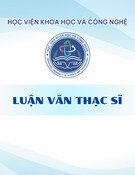
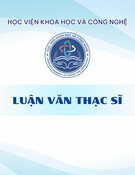
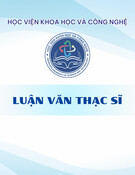
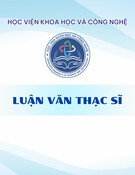
![Luận văn Thạc sĩ: Tổng hợp và đánh giá hoạt tính chống ung thư của hợp phần lai chứa phần tetrahydro-beta-carboline và imidazo[1,5-a]pyridine](https://cdn.tailieu.vn/images/document/thumbnail/2025/20250816/vijiraiya/135x160/26811755333398.jpg)
